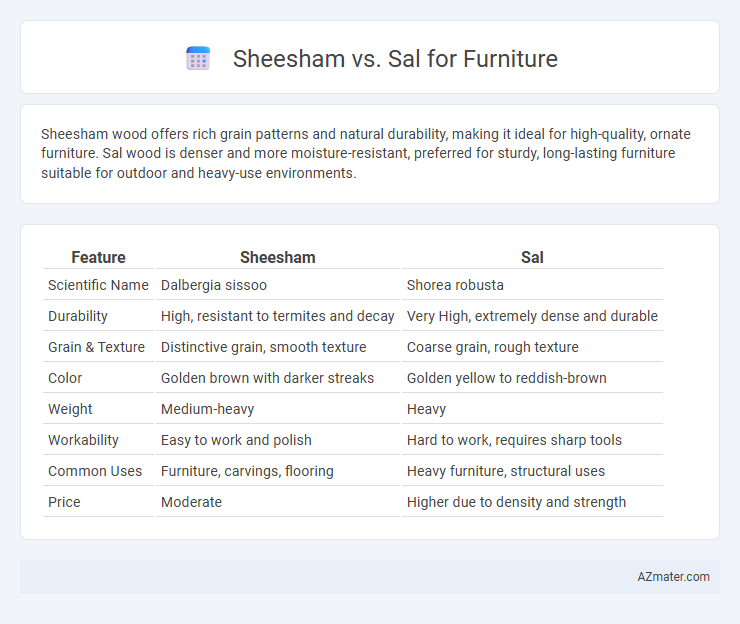Sheesham wood offers rich grain patterns and natural durability, making it ideal for high-quality, ornate furniture. Sal wood is denser and more moisture-resistant, preferred for sturdy, long-lasting furniture suitable for outdoor and heavy-use environments.
Table of Comparison
| Feature | Sheesham | Sal |
|---|---|---|
| Scientific Name | Dalbergia sissoo | Shorea robusta |
| Durability | High, resistant to termites and decay | Very High, extremely dense and durable |
| Grain & Texture | Distinctive grain, smooth texture | Coarse grain, rough texture |
| Color | Golden brown with darker streaks | Golden yellow to reddish-brown |
| Weight | Medium-heavy | Heavy |
| Workability | Easy to work and polish | Hard to work, requires sharp tools |
| Common Uses | Furniture, carvings, flooring | Heavy furniture, structural uses |
| Price | Moderate | Higher due to density and strength |
Introduction to Sheesham and Sal Wood
Sheesham wood, also known as Indian Rosewood, is prized for its rich, dark grain, high durability, and natural resistance to pests, making it an excellent choice for premium furniture. Sal wood, sourced from Shorea robusta trees, is valued for its hardness, strength, and straight grain, offering robust and long-lasting furniture solutions. Both woods provide unique aesthetic qualities and sturdy performance, catering to diverse design preferences and functional needs.
Origin and Botanical Differences
Sheesham (Dalbergia sissoo) originates from the Indian subcontinent and belongs to the Fabaceae family, known for its dense, durable timber with distinct grain patterns. Sal (Shorea robusta) is native to the Indian subcontinent as well but is part of the Dipterocarpaceae family, prized for its strength and resistance to decay. Botanically, Sheesham trees are nitrogen-fixing legumes producing hardwood ideal for fine furniture, while Sal trees yield heavy hardwood suited for robust structural use.
Grain Patterns and Aesthetic Appeal
Sheesham wood features rich, dark brown hues with intricate grain patterns that create a luxurious and elegant look, ideal for traditional and classic furniture designs. Sal wood exhibits coarser and straighter grain with a golden to reddish-brown tone, providing a robust and rustic appearance suited for sturdy, casual furniture. The intricate swirling grains of Sheesham offer superior aesthetic appeal for ornamental pieces, while Sal's uniform grain lends itself well to large, structural furniture with a natural, earthy character.
Durability and Strength Comparison
Sheesham wood, known for its dense grain and natural oils, offers superior durability and resistance to scratches, making it ideal for long-lasting furniture. Sal wood provides exceptional strength and hardness, commonly used in heavy-duty applications where structural integrity is crucial. While Sheesham excels in resistance to wear and decay, Sal's robustness ensures excellent load-bearing capacity and impact resistance for sturdy furniture pieces.
Resistance to Termites and Decay
Sheesham wood offers high resistance to termites and decay due to its natural oils and dense grain, making it a durable choice for furniture in humid or pest-prone environments. Sal wood also exhibits strong resistance to decay and termites, attributed to its hardness and natural tannins, ensuring long-lasting structural integrity. Both woods are suitable for furniture, but Sheesham tends to provide better protection against termites while Sal excels in durability under harsh weather conditions.
Workability and Craftsmanship
Sheesham wood is prized for its excellent workability, allowing craftsmen to create intricate carvings and smooth finishes due to its fine grain and moderate hardness. Sal wood, while tougher and denser, requires more effort to shape but offers superior durability and resilience in furniture construction. Both woods showcase exceptional craftsmanship potential, with Sheesham favored for detailed aesthetic work and Sal valued for robust, long-lasting pieces.
Price and Market Availability
Sheesham wood, known for its durability and rich grain, typically commands a higher price in the furniture market compared to Sal due to its aesthetic appeal and longer-lasting finish. Sal wood is more widely available across India, making its furniture generally more affordable and accessible for mass-market consumers. The market availability of Sal wood furniture is greater in commercial and bulk applications, while Sheesham is favored for premium, handcrafted pieces.
Environmental Sustainability
Sheesham and Sal woods offer distinct environmental sustainability profiles for furniture production. Sheesham, sourced predominantly from Indian subcontinental regions, is known for its rapid growth and regenerative capacity, making it a more sustainable choice due to its ability to replenish faster than Sal, which is a slow-growing hardwood native to South Asia's dense forests. Sal, while durable and long-lasting, faces sustainability challenges due to slower growth rates and overharvesting, highlighting the importance of responsible sourcing and certification to minimize ecological impact.
Best Uses for Each Wood Type
Sheesham, known for its rich grain and durability, is best suited for heavy-use furniture like dining tables and cabinets due to its resistance to warping and insect attacks. Sal wood, prized for its hardness and density, excels in outdoor furniture or structural pieces where moisture resistance and strength are critical. Both woods bring distinct aesthetics and functional advantages, making Sheesham ideal for ornate, indoor pieces while Sal serves well in robust, weather-exposed applications.
Conclusion: Choosing Between Sheesham and Sal Wood
Sheesham and Sal wood both offer exceptional durability and aesthetic appeal for furniture, with Sheesham known for its rich grain patterns and natural oil content that resists decay, while Sal is prized for its density and strength under heavy use. Selecting between the two depends largely on the desired finish and usage environment; Sheesham suits intricately carved, decorative furniture, whereas Sal excels in robust, long-lasting structural pieces. Considering factors like wood hardness, grain texture, and maintenance requirements helps determine the optimal choice for quality, longevity, and style in furniture construction.

Infographic: Sheesham vs Sal for Furniture
 azmater.com
azmater.com